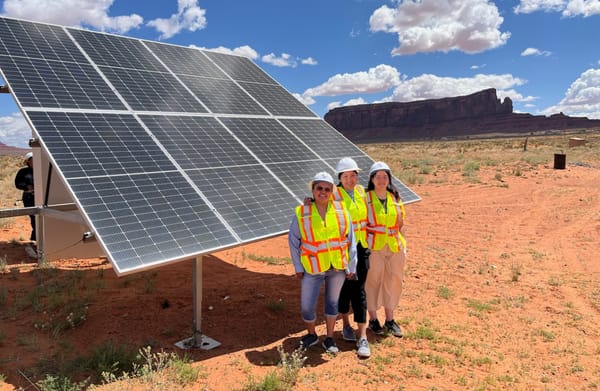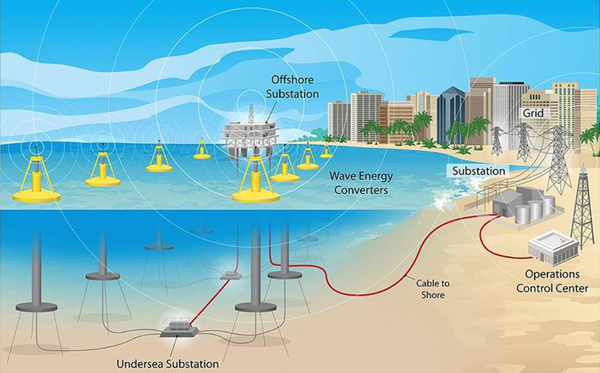What I’m reading: Sustainable aviation fuel, U.S. transit expansion, the AI power demand boom, and more

Quitting Carbon is a reader-supported publication. To support my work, please consider becoming a paid subscriber or making a one-time donation.
I have several stories in the works, including a Q&A on the zero-emissions operations initiative at a major U.S. West Coast port. For now, here is another roundup of highlights from some of what I've been reading. Enjoy!
Wind turbines are (mostly) recyclable: Unfortunately for the U.S. wind energy industry, one of President-elect Donald Trump’s bête noires is wind turbines. If it was possible to change his mind with facts, perhaps new research from the U.S. Department of Energy might prompt him to reconsider at least some of his animus towards the industry. It turns out that the U.S. can already recycle most wind turbine materials.
“Existing U.S. infrastructure could process 90% of the mass of decommissioned wind turbines,” according to a new report from a team of researchers led by the National Renewable Energy Laboratory. “However, the remaining 10% will need new strategies and innovative recycling methods to achieve a more sustainable wind energy industry.”
State of play for SAF: In the short term, experts consider so-called “sustainable aviation fuels” (SAF) sourced from feedstocks such as used cooking oil and animal fats the best option to decarbonize long-distance flights. But producing SAF at commercial scale has been a challenge. Heatmap’s Katie Brigham published a great overview of the headwinds facing the sector earlier this month.
“Aamir Shams, a senior associate at the energy think tank RMI whose work focuses on driving demand for SAF, told me that while sustainable fuel is undeniably more expensive than traditional fuel, airlines and corporations have so far been willing to pay the premium,” she writes. “We feel that the lag is happening because we just don’t have the fuel today. Whatever fuel shows up, it just flies off the shelves,” Shams said.
The Biden administration just made a big bet to boost the domestic supply of that fuel. Last week, the U.S. Department of Energy’s (DOE) Loan Programs Office closed a $1.67 billion loan guarantee with Montana Renewables to finance the expansion of its renewable fuels facility in Great Falls, Montana. The planned expansion will increase biofuels production at the facility to about 315 million gallons per year (up from 140 million gallons/yr today), most of which will be SAF.
“Once the facility reaches full capacity, Montana Renewables will be a leading global SAF producer, expected to produce about half of all North American SAF and about 12% of all global SAF through 2030,” according to DOE.
U.S. transit expansion continues: Yes, Americans love their cars but give us the option of frequent, reliable transit and many of us will choose to ride a bus or train instead. For instance, the national railway Amtrak logged 32.8 million passenger trips in fiscal year (FY) 2024, a 15% increase over FY2023 and an all-time record, Progressive Railroading reported last month.
Supported by funding from the Bipartisan Infrastructure Law, many state and local governments continue to invest in public transit upgrades, too. The best overview of where and when new transit lines will come online – in the U.S. and globally – is published each January by Yonah Freemark. In the U.S., he writes, “there are under construction 138 kilometers [86 miles] of new light rail or streetcar lines; 34 kilometers [21 miles] of new metro lines; 310 kilometers [193 miles] of new and improved bus lines; and 234 kilometers [145 miles] of regional rail or commuter rail.”
Here are links to his detailed rundowns of all the light rail, metro, and bus rapid transit projects scheduled to open in 2025 across the United States and around the world.
Renewables’ surge blunted by fossil fuels’ resilience: There is much to celebrate about the rapid deployment of grid-scale renewable energy around the globe. For instance, as a result of the closure of coal-fired power plants and the swift rollout of renewable electricity, especially offshore wind, “the UK’s electricity was the cleanest ever in 2024 … with carbon dioxide (CO2) emissions per unit falling by more than two-thirds in a decade,” according to research from Carbon Brief.
But fossil fuels are proving remarkably resilient as well. In the U.S., 96% of new power plants in 2024 were carbon-free. “Still, fossil fuels generate the majority of the country’s power and the U.S. faces an uphill battle to decarbonize its grid by 2035, a goal set by outgoing President Joe Biden,” Canary Media’s Dan McCarthy noted recently. Renewables growth could not keep pace with surging power demand in the U.S. last year, which spiked generation from natural gas power plants and meant that the country’s greenhouse gas emissions declined by just 0.2% compared to the year before, according to estimates published last week by the Rhodium Group.
“When we consider the year 2025, and the position we currently occupy in the energy transition, we might say that renewables growth has been stronger than even many of the optimists expected, but the intractability of legacy fossil fuels is far nastier than expected,” journalist and energy analyst Gregor Macdonald observed just before Christmas last year.
AI’s burgeoning grid burden: One of the reasons why fossil fuels are proving harder to snuff out on the grid is the surging demand for power from data centers – especially in the U.S., where the AI boom has thrown a lifeline to coal-fired power plants. Yesterday, President Biden issued an executive order directing the Department of Defense (DOD) and the Department of Energy to select and lease federal sites where the private sector can build data centers and accompanying power generation facilities.
“Developers selected to build on DOD and DOE sites will be required to bring online sufficient clean energy generation resources to match the full electricity needs of their data centers,” according to a White House press statement.
“This year will go down in history as the year the energy sector woke up to AI. ... This is also the year AI woke up to energy,” BloombergNEF Founder and Senior Contributor Michael Liebreich wrote in a post published on Christmas Eve 2024. Do read the whole essay. It’s an exhaustive, measured deep dive into data center power demand estimates as well as potential solutions to blunt and meet that demand.
“In the end, the tech titans will find out that the best way to power AI data centers is in the traditional way, by building the same generating technologies as are proving most cost effective for other users, connecting them to a robust and resilient grid, and working with local communities. More, in other words, of what the best of them are already doing,” he concludes.
In a story published last week at Heatmap, Emily Pontecorvo highlighted new research that explores another (mostly) clean solution to meet data center power demand. “After a year of concerted hand-wringing about the growing energy needs of data centers, a report that dropped just before the holidays proposed a solution that had been strangely absent from the discussion. ... In a pithily named new analysis – ‘Fast, scalable, clean, and cheap enough’ – the report’s authors make a compelling case for an alternative: off-grid solar microgrids.”
Bonus: Ghosts in the water: I am determined to make it to the bottom of the stack of New Yorker back issues next to my reading chair because I know there are gems waiting in the pile. Here is another one. In June, Paige Williams published a dispatch from Maine’s Down East coastal region profiling men and women who harvest glass eels, or elvers – what National Fisherman magazine calls “likely the most valuable fish in the United States on a per-pound basis.”
The story is an example of how the best journalism can transport us to another world. I was rapt reading several thousand words as Williams illuminated an industry and way of life I didn’t know existed and described places I’ve never been and may never see in person.
But what I’ll always remember from the story is veteran elverwoman Julie Keene explaining why her chosen profession means so much to her: “It’s not just about how much money you can make. It’s about seeing the alewives trying to get upriver, and an eagle fishing for them. And hearing the river at night. When you see millions and millions and millions of elvers, it’s mind-blowing. You see full moons. You see rings around the moon. You see fog. If you see garbage, you pick it up. You want passage for all the things that are trying to get into the lakes to spawn. You want it to be – not ruined.”




